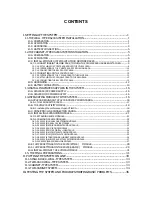
QX50/QX200/QX2000; (SW Version 6.0.x)
44
QX50/QX200/QX2000 Manual III: Extension User’s Guide
Appendix: Glossary
A
Asymmetric Digital Subscriber Line (ADSL)
- is a method for moving data over regular phone lines. An ADSL circuit is much faster than a regular phone
connection, and the wires coming into the subscriber's premises are the same (copper) wires used for regular phone service. An ADSL circuit must be
configured to connect two specific locations, similar to a leased line. A commonly discussed configuration of ADSL would allow a subscriber to receive data
(download) at speeds of up to 1.544 Megabits per second, and to send (upload) data at speeds of 128 kilobits per second. Thus is the 'Asymmetric' part of
acronym. Another commonly discussed configuration would be symmetrical: 384 kilobits per second in both directions. In theory ADSL allows download
speeds of up to 9 megabits per second and upload speeds of up to 640 kilobits per second. ADSL is often discussed as an alternative to ISDN, allowing
higher speeds in cases where the connection is always to the same place.
Asynchronous Transfer Mode (ATM) -
a 53-byte cell-switching technology well suited for carrying voice, data, and video traffic on the same
infrastructure. It is inherently scalable in throughput and was designed to provide Quality of Service (QoS).
Auto Attendant (AA)
- a feature providing remote access to QX voice connectivity services. Specifically, it supports remote connection to QX extensions,
to their mailboxes and for making calls to other destinations. Remote access to QX AA is possible through IP and PSTN calls.
Auto Redial -
a service that allows automatically recalling the destination that was busy.
C
Call
- establishment of (or attempt to establish) a voice or data connection between two endpoints, or between two points that provide a partial link (e.g.,
a trunk) between two endpoints.
Call Blocking -
a QX service that allows blocking unwanted incoming or outgoing calls over QX.
Call Forwarding
- a QX service that allows transferring a call to another destination in case the QX user is busy, not answering or unconditional.
Call Hold -
a QX service that allows holding the call in order to make another one, or to answer the second incoming call. The first call partner will listen to
music while being on hold.
Call Waiting
- a QX service that allows receiving a second call while being busy with the first one. The waiting party will hear a beeping during the
conversation.
Caller ID
- caller information is displayed on the called party’s phone.
Central Office (CO)
- a local switching system that connects lines to lines and lines to trunks. Sometimes used to refer to the building in which a switching
system is located and the associated equipment. It is also the physical point where calls enter the long distance network.
CODEC -
COmpression/DECompression that transforms analog voice into a digital bit stream and vice-versa. It is now an overall term for the technology
used in digital audio and video.
D
D-channel -
In ISDN, the 16-kb/s segment of a 144-kb/s, full-duplex subscriber service channel that is subdivided into 2B+D channels, i.e., into two
64-kb/s clear channels and one 16-kb/s channel for the ISDN basic rate.
Note 1
: The D channel is usually used for out-of-band signaling. The two 64-kb/s
clear channels are used for subscriber voice and data services.
Note
2
: The D-channel specifications are addressed in the CCITT Recommendation for the
Integrated Services Digital Network (ISDN).
Note 3
: The D-channel may be 64 kb/s for the primary rate ISDN service.
Data Encryption Standard (DES)
- a block cipher algorithm for encrypting (coding) data so it is nearly impossible for anyone without the decryption key
to get the data back in unscrambled form. The DES standard enciphers and deciphers data using a 64-bit key
.
Daylight saving time
(
DST)
- a convention of advancing clocks so that afternoons have more daylight and mornings have less. Typically clocks are
adjusted forward one hour near the start of spring and are adjusted backward in autumn.
Dial peer
- an addressable call endpoint. In Voice over IP (VoIP), there are two types of dial peers: POTS and VoIP.
Dial plan
- a description of the dialing arrangements for customer use on a network.
Digital Signal Processor (DSP) -
A specialized microprocessor that performs calculations on digitized signals that were originally analog, and then
forwards the results. The big advantage of DSPs lies in their programmability. DSPs can be used to compress voice signals to as little as 4,800 bps. DSPs are
an integral part of all voice processing systems and fax machines.
Digital Subscriber Line (DSL)
- public network technology that delivers high bandwidth over conventional copper wiring at limited distances. There are
four types of DSL: ADSL, HDSL, SDSL, and VDSL. All are provisioned via modem pairs, with one modem located at a central office and the other at the
customer site. Since most DSL technologies do not use the entire bandwidth of the twisted pair, there remains room for a voice channel.
Distinctive Ringing
- QX service that allows a specific ringing pattern assignment for particular callers over QX.
Domain -
a place on the Internet you can visit with your browser, i.e., a www site. It also might be a single computer or computers masqueraded as a
single computer. On the Internet, the domain is the address that gets you there.
Domain name -
in a network using the TCP/IP, the full domain name consists of a sequence of names (labels) separated by periods (dots), for example,
qx.epygi.com.

























